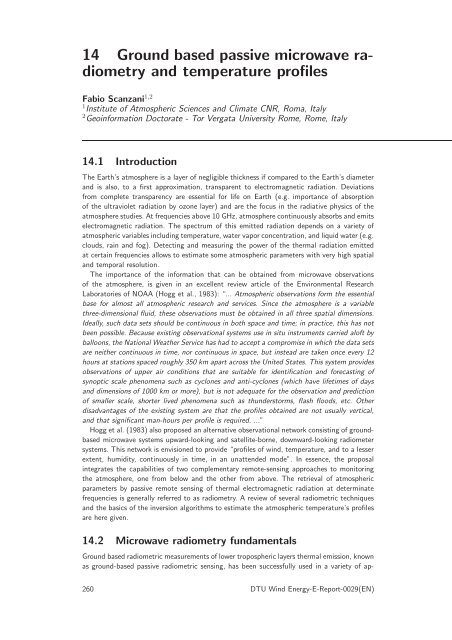Publishers version - DTU Orbit
Publishers version - DTU Orbit
Publishers version - DTU Orbit
You also want an ePaper? Increase the reach of your titles
YUMPU automatically turns print PDFs into web optimized ePapers that Google loves.
14 Ground based passive microwave radiometry<br />
and temperature profiles<br />
Fabio Scanzani 1,2<br />
1 Institute of Atmospheric Sciences and Climate CNR, Roma, Italy<br />
2 Geoinformation Doctorate - Tor Vergata University Rome, Rome, Italy<br />
14.1 Introduction<br />
The Earth’s atmosphere is a layer of negligible thickness if compared to the Earth’s diameter<br />
and is also, to a first approximation, transparent to electromagnetic radiation. Deviations<br />
from complete transparency are essential for life on Earth (e.g. importance of absorption<br />
of the ultraviolet radiation by ozone layer) and are the focus in the radiative physics of the<br />
atmospherestudies.Atfrequenciesabove10GHz,atmospherecontinuouslyabsorbsandemits<br />
electromagnetic radiation. The spectrum of this emitted radiation depends on a variety of<br />
atmosphericvariablesincludingtemperature,watervaporconcentration,andliquidwater(e.g.<br />
clouds, rain and fog). Detecting and measuring the power of the thermal radiation emitted<br />
at certain frequencies allows to estimate some atmospheric parameters with very high spatial<br />
and temporal resolution.<br />
The importance of the information that can be obtained from microwave observations<br />
of the atmosphere, is given in an excellent review article of the Environmental Research<br />
Laboratories of NOAA (Hogg et al., 1983): “... Atmospheric observations form the essential<br />
base for almost all atmospheric research and services. Since the atmosphere is a variable<br />
three-dimensional fluid, these observations must be obtained in all three spatial dimensions.<br />
Ideally, such data sets should be continuous in both space and time; in practice, this has not<br />
been possible. Because existing observational systems use in situ instruments carried aloft by<br />
balloons,the NationalWeatherService hashad to acceptacompromisein whichthe data sets<br />
are neither continuous in time, nor continuous in space, but instead are taken once every 12<br />
hours at stations spaced roughly 350 km apart across the United States. This system provides<br />
observations of upper air conditions that are suitable for identification and forecasting of<br />
synoptic scale phenomena such as cyclones and anti-cyclones (which have lifetimes of days<br />
and dimensions of 1000 km or more), but is not adequate for the observation and prediction<br />
of smaller scale, shorter lived phenomena such as thunderstorms, flash floods, etc. Other<br />
disadvantages of the existing system are that the profiles obtained are not usually vertical,<br />
and that significant man-hours per profile is required. ...”<br />
Hogg et al. (1983) also proposed an alternative observational networkconsistingof groundbased<br />
microwave systems upward-looking and satellite-borne, downward-looking radiometer<br />
systems. This network is envisioned to provide “profiles of wind, temperature, and to a lesser<br />
extent, humidity, continuously in time, in an unattended mode”. In essence, the proposal<br />
integrates the capabilities of two complementary remote-sensing approaches to monitoring<br />
the atmosphere, one from below and the other from above. The retrieval of atmospheric<br />
parameters by passive remote sensing of thermal electromagnetic radiation at determinate<br />
frequencies is generally referred to as radiometry. A review of several radiometric techniques<br />
and the basics of the in<strong>version</strong> algorithms to estimate the atmospheric temperature’s profiles<br />
are here given.<br />
14.2 Microwave radiometry fundamentals<br />
Ground basedradiometricmeasurementsoflowertroposphericlayersthermalemission,known<br />
as ground-based passive radiometric sensing, has been successfully used in a variety of ap-<br />
260 <strong>DTU</strong> Wind Energy-E-Report-0029(EN)

















